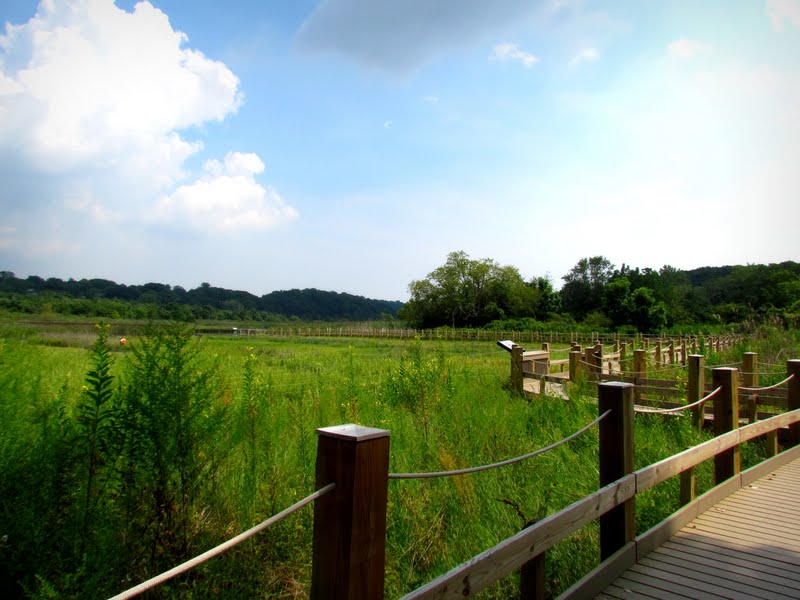Ecosystem Targets and Supporting Indicators
Tidal Wetlands Restored
Restore an additional 515 acres of tidal wetlands by 2035 from a 2014 baseline.
View Implementation Actions for Tidal Wetlands RestoredProgress
| Tidal Wetland Acres Restored | ||
|---|---|---|
| Year | Acres | Cumulative Acres |
| 1998 | 34.9 | 34.9 |
| 1999 | 108.0 | 142.9 |
| 2000 | 81.2 | 224.1 |
| 2001 | 6.7 | 230.8 |
| 2002 | 116.4 | 347.2 |
| 2003 | 26.2 | 373.4 |
| 2004 | 20.5 | 393.9 |
| 2005 | 43.5 | 437.4 |
| 2006 | 31.5 | 468.9 |
| 2007 | 4.8 | 473.7 |
| 2008 | 12.0 | 485.7 |
| 2009 | 5.0 | 490.7 |
| 2010 | 203.5 | 694.1 |
| 2011 | 27.3 | 721.4 |
| 2012 | 242.5 | 963.8 |
| 2013 | 5.0 | 968.8 |
| 2014 | 22.7 | 991.5 |
| 2015 | 38 | 1,029.5 |
| 2016 | 27.5 | 1,057.0 |
| 2017 | 0.1 | 1,057.1 |
| 2018 | 3.7 | 1,060.8 |
| 2019 | 1.9 | 1,062.7 |
| 2020 | 8.5 | 1,071.2 |
| 2021 | 0.1 | 1,071.3 |
| 2022 | 85.9 | 1,157.2 |
| 2023 | 0.1 | 1,157.3 |
| 2024 | 0 | 1,157.3 |
| Percent to Target | |||
|---|---|---|---|
| Year | Acres | Cumulative Acres | Percentage Towards 2035 Target (515 more acres) |
| 2014 | 0 | 0 | 0% |
| 2015 | 38 | 38 | 7.4% |
| 2016 | 27.5 | 65.5 | 12.7% |
| 2017 | 0.1 | 65.6 | 12.7% |
| 2018 | 3.7 | 69.3 | 13.4% |
| 2019 | 1.9 | 71.2 | 13.8% |
| 2020 | 8.5 | 79.7 | 15.5% |
| 2021 | 0.1 | 79.8 | 15.5% |
| 2022 | 85.9 | 165.7 | 32.2% |
| 2023 | 0.1 | 165.8 | 32.2% |
| 2024 | 0 | 165.8 | 32.2% |
Status and Trends
Progress for reaching this target is behind schedule. In order to restore 515 acres by 2035, an average of 32 acres a year needs to be restored. Since 2015, 165.8 acres, or an average of 15.1 acres a year, have been restored.
Zero acres of tidal wetlands were restored in 2024.
Since 1998, 1,157.3 acres of tidal wetlands have been restored around the Sound, but more than 93 percent of that total was completed prior to 2014. Many earlier projects targeted the largest degraded marsh complexes and involved increasing tidal flow, such as by removing tidal gates, and treating the invasive species Phragmites australis. These projects created favorable conditions to restore degraded tidal wetland habitats and restore wetlands of 50 acres in size or more.
Progress, however, was made in 2022 with two large projects, which helped make 2022 the best year for tidal wetlands restoration since 2012. At the Cove River in New Haven 50 acres of tidal wetlands were restored through the installation of a pair of self-regulating tide gates. At Great Meadows Marsh in Stratford, CT 34 acres were restored, including by removing fill that was dumped into wetlands in the 1950s and replacing it with clean sediment. That project, which had received support from the Long Island Sound Study, was featured in an article last year in Sound Spotlight.
While there are fewer of these types of projects available now, LISS is trying to get on track toward meeting its target by investing in more challenging restoration projects, including projects that involve multiple habitat types and target Species of Greatest Conservation Need, and using innovative restoration techniques, such as thin layer deposition. In addition, LISS is building capacity and investing in modeling, management, and planning efforts in order to identify priority tidal wetlands sites along the Sound’s coast in need of restoration.
About 51 percent of coastal habitat acres restored in Long Island Sound since 1998 is made up of tidal wetlands.
Challenges
Restoration of many larger tidal wetland complexes has been completed. Future restorations will target more small, isolated wetlands. Sea level rise may impair the function of existing wetlands or change their area and location.
How is This Target Measured?
The Long Island Sound Study Habitat Restoration Coordinators track coastal habitat restoration projects that are in progress within the watershed by various partners and report the total acres restored annually.
For the purposes of this metric, a wetland is considered “restored” after completion of the construction phase. Restoration involves a successful effort to restore tidal flow (e.g., culvert enlargement, fill removal) and return native plants to the site (planting, invasive plant species removal).
Importance
Tidal wetlands are transitional zones between the land and submerged systems. These areas are dominated by rooted plants that are flooded by the tide. Healthy tidal wetlands help trap sediments, store floodwater, and reduce wave energy during storms. Two-thirds of all marine species depend on tidal wetlands for a portion of their life cycle.
Additional Information
The Long Island Sound Study has a database to track and describe every restoration project in the Connecticut and New York portions of the Long Island Sound watershed since 1998.
Contact
Sara Cernadas-Martin, New York Department of Environmental Conservation, sara.cernadas@dec.ny.gov
Harry Yamalis, Connecticut Department of Energy and Environmental Protection, harry.yamalis@ct.gov
Source of Data
CT DEEP, NYSDEC, and Long Island Sound Study Partners
DATA NOTES
- The technical explanation on how the target was selected is found in Appendix B of the Comprehensive Conservation and Management Plan.
- The Tidal Wetland target is a component of the Coastal Habitat Extent target.
